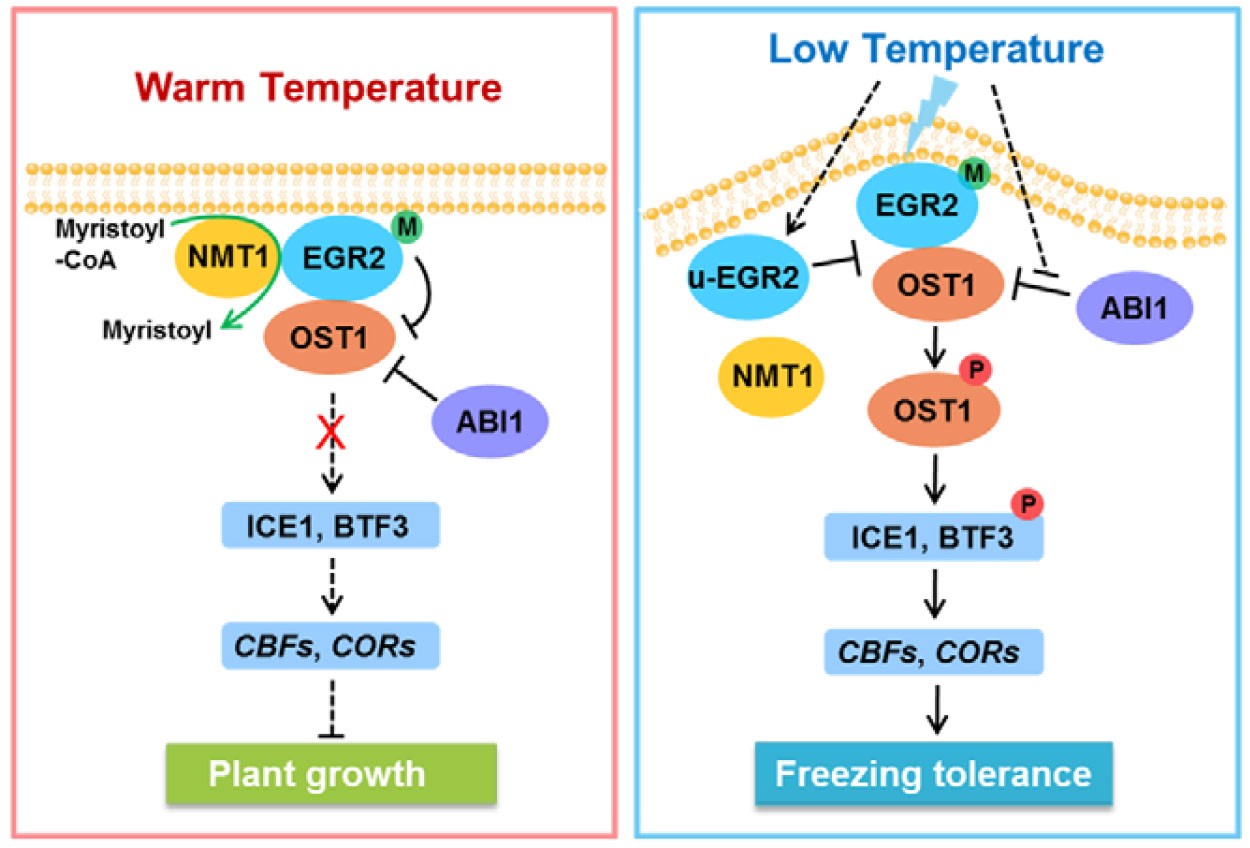博文
The EMBO Journal:拟南芥EGR2磷酸酶介导植株低温胁迫抗性
||
EGR2 phosphatase regulates OST1 kinase activity and freezing tolerance in Arabidopsis
First author: Yanglin Ding; Affiliations: China Agricultural University (中国农业大学): Beijing, China
Corresponding author: Shuhua Yang
OST1 (open stomata 1) protein kinase (激酶) plays a central role in regulating freezing tolerance in Arabidopsis; however, the mechanism underlying cold activation of OST1 remains unknown. Here, we report that a plasma membrane‐localized clade‐E growth‐
egulating 2 (EGR2) phosphatase (磷酸酶) interacts with OST1 and inhibits OST1 activity under normal conditions. EGR2 is N‐myristoylated byN‐myristoyltransferase (N-肉豆蔻酰基转移酶) NMT1 at 22°C, which is important for its interaction with OST1. Moreover, myristoylation of EGR2 is required for its function in plant freezing tolerance. Under cold stress, the interaction of EGR2 and NMT1 is attenuated (减弱), leading to the suppression of EGR2 myristoylation in plants. Plant newly synthesized unmyristoylated EGR2 has decreased binding ability to OST1 and also interferes with the EGR2‐OST1 interaction under cold stress. Consequently, the EGR2‐mediated inhibition of OST1 activity is released. Consistently, mutations of EGRs cause plant tolerance to freezing, whereas overexpression of EGR2 exhibits decreased freezing tolerance. This study thus unravels a molecular mechanism underlying cold activation of OST1 by membrane‐localized EGR2 and suggests that a myristoyl (肉豆蔻酰) switch on EGR2 helps plants to adapt to cold stress.
OST1蛋白激酶在调控拟南芥的耐冻性方面扮演重要的作用,然而OST1的低温激活机制还不清楚。本文中,作者报道了一个定位于质膜的EGR2磷酸酶与OST1相互作用,在正常条件下抑制OST1的活性。N-肉豆蔻酰基转移NMT1能够在22°C条件下肉豆蔻酰基化EGR2,这对于NMT1与OST1的互作是非常重要的。此外,EGR2的肉豆蔻酰基化对于植株的耐冻性是必需的。在冷胁迫下,NMT1与EGR2的互作减弱,导致了植株中EGR2肉豆蔻酰基化的抑制。植株中新合成的未肉豆蔻酰基化的EGR2与OST1结合的能力也有所降低,同时在冷胁迫下干扰EGR2‐OST1的互作。因此,EGR2介导的OST1活性抑制得到缓解。另外,EGRs的突变增强了植株对冻害的抗性,而过表达EGR2基因降低植株对于冻害的抗性。本文的研究揭示了OST1低温激活的底层分子机制,主要由定位于膜上的EGR2蛋白介导的肉豆蔻酰化控制,进而提升植株对于低温胁迫的适应。
通讯:杨淑华 (http://cbs.cau.edu.cn/art/2018/9/14/art_31816_594296.html)
个人简介:1987-1991年,南开大学,学士;1991-1994年,南开大学,硕士;1998-2002年,新加坡国立大学,博士;2002-2004年,美国康奈尔大学,博士后。
研究方向:植物感知和响应低温胁迫的分子机理。
doi: 10.15252/embj.201899819
Journal: The EMBO Journal
Published online: 14 November, 2018
https://blog.sciencenet.cn/blog-3158122-1147533.html
上一篇:New Phytologist:番茄Whirly1增强植株低温胁迫抗性
下一篇:Gene & Development:生长素诱导植物种子发育综述
全部作者的其他最新博文
- • Plant Physiology:CsMADS3促进柑果中的叶绿素降解和类胡萝卜素合成(华中农业大学)
- • Molecular Plant:LBD11-ROS反馈调节作用于拟南芥的维管形成层增殖和次生生长(浦项科技大学)
- • Science Advances:根结线虫通过调控植物的CLE3-CLV1模块,促进侵染进程(日本熊本大学)
- • Nature Communications:油菜素内酯参与植物营养生长期转变的分子机制解析(浙江农林大学)
- • Current Biology:光合作用产生的蔗糖驱动侧根“生物钟”(德国弗莱堡大学)
- • PNAS:花同源异型基因在叶中被抑制、花中被激活的分子机制(南卡罗来纳大学)

